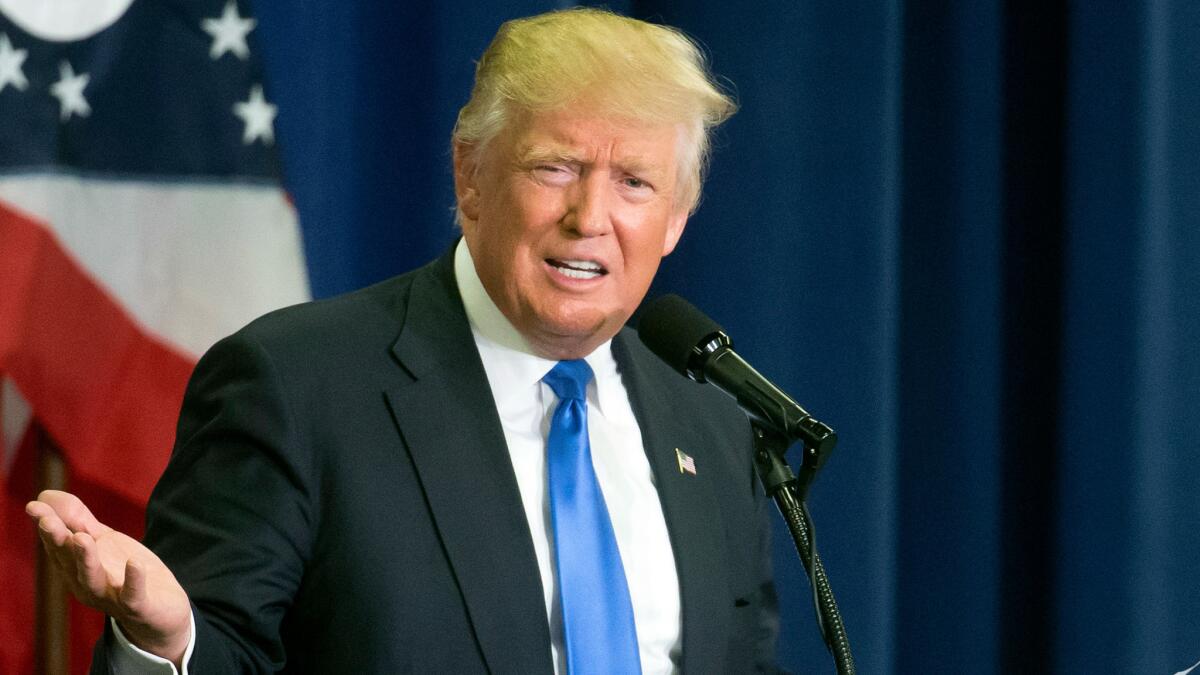Trump healthcare plan would cut some premiums but leave 18 million uninsured, study finds

- Share via
Donald Trump’s healthcare plan would make 18 million people uninsured, but also lower premiums significantly for policies purchased directly by consumers, according to an independent study released Thursday.
The new policies would be stingier than what’s sold now.
Trump’s plan would have little effect on people covered by employers and those on Medicare. But millions of low-income adults covered by the Medicaid expansion in President Obama’s healthcare law would lose newly gained benefits. Separately, taxpayers may save money because the government no longer would have to subsidize insurance for millions of citizens.
The analysis by the nonpartisan Center for Health and Economy attempts to put some numbers to the healthcare concepts outlined on the Republican presidential candidate’s website. The center is a research group that includes liberal and conservative experts.
The study found “substantial uncertainty” about one of Trump’s main ideas: allowing insurers to sell policies across state lines to promote competition. In 10 years’ time, it could lead to as many as 7 million people getting individual policies, or as few as 1 million.
Some of that uncertainty stems from the fact that health insurance remains a local and regional business. Costs can vary dramatically across the country. A Texas company selling policies in New York City would have to charge higher premiums. Also, out-of-state insurers may struggle to build the networks of doctors and hospitals needed to attract consumers.
“The biggest wild card is [Trump’s] approach to allowing people to buy across state lines,” said Douglas Holtz-Eakin, a Republican economist and a board member of the center.
There was no immediate comment from the Trump campaign.
The analysis assumes that a President Trump and a Republican Congress would be able to completely repeal Obama’s Affordable Care Act.
Insurance losses would be swift and fall mainly on people covered through Medicaid. The healthcare law offers states an enhanced federal payment to expand their Medicaid programs and enroll low-income adults. Trump’s plan would turn Medicaid into a block grant, meaning that federal money would be limited and states would get more leeway on how to spend their allotment.
Among people who buy health insurance directly, there would be winners and losers.
The unpopular requirement to carry health insurance would disappear, but there would be no federal guarantee that people with health problems could get coverage.
HealthCare.gov’s online insurance market would be gone, along with tax credits for premiums and subsidies for out-of-pocket costs. Individuals and families would be able to deduct their premiums from taxes, but that doesn’t help as many people as the upfront tax credits that are now available -- particularly for those with modest incomes.
Also eliminated would be the healthcare law’s minimum-benefit requirements, financial protections and limitations on charging higher premiums to older adults, all of which make coverage more expensive. Insurers would respond by offering skimpy low-cost plans appealing to healthy young adults, for whom the healthcare law has been a tough sell. Average premiums would fall by more than 20%.
Over time, more people would purchase the new kinds of coverage. But by 2026 there would still be 13 million more uninsured than currently projected under the healthcare law, and they could be older, sicker people.
ALSO
Trump says he admired Saddam Hussein only for how he killed terrorists
Trump and Clinton are giving people lots of reasons to vote against them
Hillary Clinton extends an olive branch to Bernie Sanders while whacking Donald Trump
More to Read
Inside the business of entertainment
The Wide Shot brings you news, analysis and insights on everything from streaming wars to production — and what it all means for the future.
You may occasionally receive promotional content from the Los Angeles Times.










